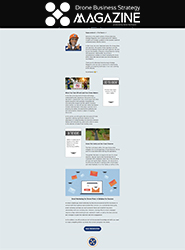
As drone technology rapidly evolves, understanding the environment around us—both the opportunities and threats—is crucial for success in the drone service business. Navigating this shifting landscape requires staying informed about developments that can either boost or challenge our operations.
At the AUVSI New England Summit, experts emphasized the importance of the Department of Defense’s (DoD) role in addressing UAS (Unmanned Aircraft Systems) threats and how their strategies impact the drone industry.
This article explores how these efforts shape the airspace landscape and what drone pilots can learn from them.
The Growing Drone Threat
Drones have become essential in many fields, yet they bring risks that could adversely impact operations. From smuggling attempts to concerns over potential weaponization, UAS threats are on the rise. Blake Stone from the Joint Counter-sUAS Office (JCO) stressed the urgency of dealing with these risks. The DoD focuses on protecting military and federal zones, but gaps remain at the local and state levels, where resources are limited. Collaboration between these sectors is essential for comprehensive threat management and for businesses to understand the evolving regulatory context.
The Legal Hurdles
One of the biggest challenges in responding to drone threats is the current legal framework. Laws are in place to ensure privacy and protect civil liberties, but they also restrict how authorities can handle dangerous drones. The Federal Aviation Administration (FAA) regulates UAS use to keep airspace safe but often ties the hands of security forces. For drone service businesses, this highlights the need to stay compliant while being aware of new regulations. Stone emphasized that balancing security needs with public safety and rights remains a delicate yet necessary effort.
The DoD’s Technological Response
The DoD is investing in new technologies to monitor and mitigate UAS threats efficiently. Real-time data-sharing programs and advanced detection systems are being developed to neutralize risks without harming bystanders. These initiatives require collaboration with tech innovators, highlighting the value of partnerships in driving technological advancements. For drone pilots, understanding these developments can inform best practices, from flight planning to risk assessment. AI-powered solutions and adaptive counter-drone systems could one day integrate into civilian sectors, reshaping how businesses approach operational safety.
The Private Sector’s Role
Another key theme from the summit was the vital role of private companies. Manufacturers and drone operators can greatly influence airspace safety. Stone and other panelists argued that businesses should be proactive in adopting safety technologies and ensuring compliance. Innovations like remote identification not only protect the airspace but also promote public trust in drone operations. Companies already investing in safety measures are setting industry standards, creating a more stable and predictable environment for all drone services.
Building an Effective Framework
The summit made it clear that effective UAS threat management requires everyone to work together. No single organization can handle this complex issue alone. Stone called for better communication and trust among federal, state, and private entities to create an adaptable defense framework. For drone pilots, this means staying informed and being part of industry discussions. International collaboration is also key, with the Department of Homeland Security (DHS) working to align global standards. Businesses should be aware of these trends, which could influence regulations and opportunities for international operations.
The Takeaway
Drones offer incredible opportunities, but the threat landscape is always changing. By understanding how agencies like the DoD are working to secure our skies, drone pilots and businesses can better prepare for what’s ahead. Staying updated on legal changes, technological advancements, and cooperative efforts will keep you competitive and compliant.
The AUVSI New England Summit highlighted both the challenges and the progress being made. As the industry continues to grow, being equipped with the latest knowledge and adaptive strategies will help ensure long-term success.
Fly smart, stay sharp, and your drone business will soar to new heights. 😉 T
If you have any questions, let us know! If you’d like to hire us, you can get more information here.
Written by: Tony Marino, MBA – FAA Certified Part 107 Commercial Drone Pilot and Chief Business Strategist at Aerial Northwest
Disclaimer: The information provided in this blog post is for general informational purposes only and should not be construed as legal advice.
Resources
- FAA Resources: FAA DroneZone
- McNabb, M. (2024, October 30). AUVSI New England Summit panel highlights DoD’s role in tackling domestic UAS threats. DRONELIFE. https://dronelife.com/2024/10/30/auvsi-new-england-summit-panel-highlights-dods-role-in-tackling-domestic-uas-threats/
- Federal Aviation Administration. (n.d.). UAS overview. FAA. https://www.faa.gov/uas
- Department of Homeland Security. (n.d.). Countering UAS threats. DHS. https://www.dhs.gov/
- Joint Counter-sUAS Office. (n.d.). Mission and strategy. JCO.
- Association for Unmanned Vehicle Systems International. (2024). Key takeaways from the AUVSI New England Summit. AUVSI News. https://www.auvsi.org/news
- Article: Drone Pilot Aerial Photography Business Plan Blueprint 2024
- Article: Top 5 Drone Pilot Marketing Channels for 2024

DRONE BUSINESS STRATEGY MAGAZINE
A free digital publication made exclusively for all small business drone pilots to them help start-up, become profitable while sustaining a competitive advantage within the drone service industry sector they opt to serve.
“If you love to fly, we’d love to have you come aboard!”
We share your information with no one. Our Privacy Policy.









Leave a Reply
Your email is always safe with us.